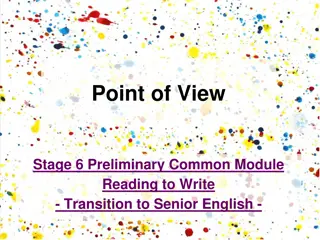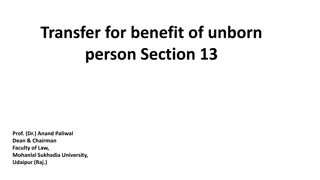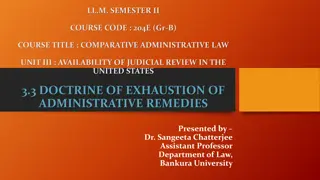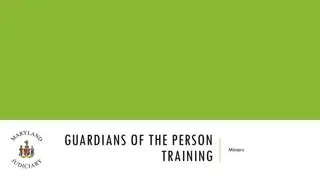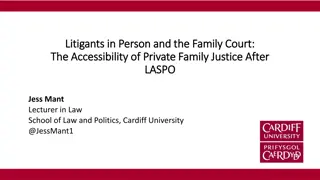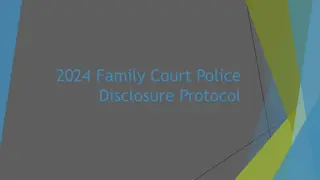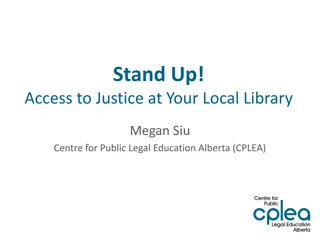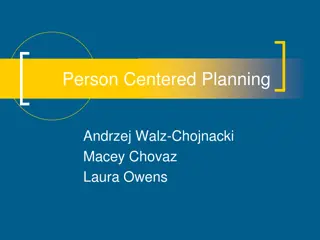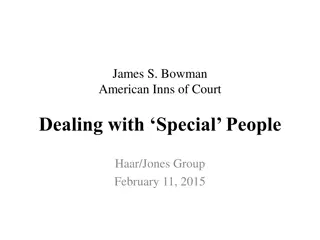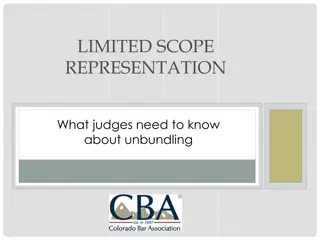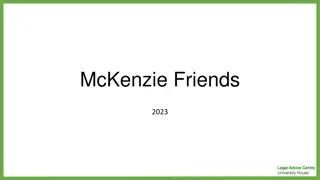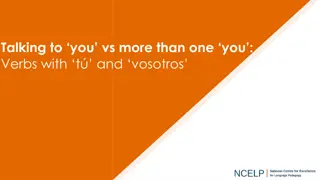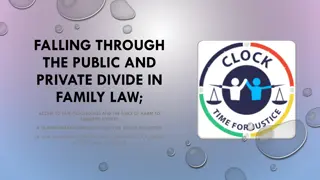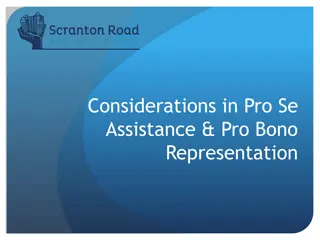Understanding Litigants in Person: A Comprehensive Guide
Explore the court's perspective on litigants in person, with insights from the Barton v Wright-Hassall LLP [2018] UKSC 12 case. Learn about the significance of LiPs, the impact on justice accessibility, and key legal considerations pre-Barton. Gain practical tips for briefing counsel effectively. Delve into relevant cases highlighting judicial responses to unrepresented parties' challenges.
- Litigants in Person
- Barton v Wright-Hassall LLP
- Access to Justice
- Legal Proceedings
- Briefing Counsel
Download Presentation

Please find below an Image/Link to download the presentation.
The content on the website is provided AS IS for your information and personal use only. It may not be sold, licensed, or shared on other websites without obtaining consent from the author. Download presentation by click this link. If you encounter any issues during the download, it is possible that the publisher has removed the file from their server.
E N D
Presentation Transcript
An Essential Guide to dealing with Litigants in Person Discussing the court s approach to Litigants in person and the application of the Supreme Court decision in Barton v Wright- Hassall LLP [2018] UKSC 12 and related cases. Top Tips: Preparing the Brief to Counsel A one-stop shop for information and guidance about how to prepare the brief/instructions to counsel on a range of matters. Speakers Kate Richmond Scott Storey
An Essential Guide to Litigants-in-person (LiP s) KATE RICHMOND ONE CROWN OFFICE ROW
Who are LiPs and why are they important? Who are LiP s? A LiP is the sole term used to describe individuals who exercise their right to conduct legal proceedings on their own behalf. In practice, a LiP can also be known as an unrepresented party , a self-represented party or a self-represented litigant . Why is it important to be aware of LiP s? LiP s highlight the fundamental importance of access to justice for litigants Family Court quarterly statistics for Q4 of 2017 show 37% of disposals in private law cases involved unrepresented parties on both sides, the highest on record In December 2017, the Lord Chief Justice highlighted the ongoing issues relating to the rise in LiP s in the court system: https://www.judiciary.uk/wp-content/uploads/2017/12/lcj- press-conference-20171205.pdf
The law before Barton Mole v Hunter [2014] EWHC 658 (QB), Tugendhat J commented at [107] that reform of the rules was unnecessary to deal with the effect that litigants in person were increasingly having on the courts. CPR 3.1A Case Management - unrepresented parties came into force on 1 October 2015. Akcine Bendore Bankas Snoras (in Bankruptcy) v Yampolskaya [2015] EWHC 2136 (QB), Green J at paragraph 25: It is accepted that in principle a court might well take the fact that a litigant in person is indigent or impecunious, or unable to speak the language into account Not every litigant in person is to be treated as the same.
Agarwala v Agarwala [2016] EWCA Civ 1252 Lady Justice King: Whilst every judge is sympathetic to the challenges faced by litigants in person, justice simply cannot be done through a torrent of informal, unfocussed emails, often sent directly to the judge and not to the other parties In my view judges must be entitled, as part of their general case management powers, to put in place, where they feel it to be appropriate, strict directions regulating communications with the court and litigants should understand that failure to comply with such directions will mean that communications that they choose to send, notwithstanding those directions, will be neither responded to nor acted upon.
Barton v Wright Hassall LLP [2016] EWCA Civ 177 Mr Barton applied for an order under CPR 6.15(2) that steps he had taken to bring his claim form to Wright Hassall s attention should count as good service. At first instance, the district judge concluded that there was no good reason to exercise discretion under CPR 6.15 to permit service by alternative means. Mr Barton s appeal was dismissed, the judge finding that there was no good reason why Mr Barton had not served the claim form during its validity. Mr Barton appealed to the Court of Appeal who considered: The mere fact that a party is a litigant in person cannot on its own amount to a good reason, although it may have some relevance at the margins [19]
Clarity in light of Barton v Wright- Hassall LLP [2018] UKSC 12 The standard of compliance with rules or orders of the court are the same for litigants-in-person as they are for represented parties [18]; However, the court may make allowances for litigants-in- person when it comes to case management decisions and how hearings are conducted; Examples include: longer time limits for compliance with directions; The court assisting unrepresented parties to present their evidence during trial. Litigants-in-person are expected to know the rules unless they are particularly inaccessible or obscure [18];
A tougher approach in Reynard v Fox [2018] EWHC 443 (Ch) HHJ Matthews applies the principles in Barton to strike out an LiP s claim which had already been decided in April 2015. An issue for the court was whether it was unjust to strike out the claim because he had not brought it under the relevant section of the Insolvency Act 1986 because he was a litigant in person and did not have a detailed knowledge of insolvency regulations. On the case law, HHJ Matthews found the fact that a litigant had been acting in person was not of itself a reason to dis-apply procedural rules, orders or directions, or excuse non-compliance with them. The exception was that a special indulgence to a litigant in person might be justified where a rule was hard to find, difficult to understand, or ambiguous [44], [45].
Best practice when dealing with LiPs Use clear, concise language make it google-able ; Explain any necessary legal jargon; Recommend to a LiP that they seek independent legal advice identify relevant advice or support agencies (CAB, Shelter, Bar pro bono centre, LawWorks); Refer LiP s to CPR, FPR or Crim PR at the earliest opportunity; Set clear parameters about email & telephone communication with each party & the court at the outset of the matter; Explain at the outset the extent and limits to the assistance that you can provide to LiP s; Be flexible not all LiP s are the same.
Further information Litigants in person: guidelines for lawyers on the Law Society website: (http://www.lawsociety.org.uk/support- services/advice/articles/litigants-in-person-new-guidelines-for- lawyers-june-2015/) Practice Guidance from the Master of the Rolls on LiPs March 2013: Practice Guidance (Terminology for Litigants in Person) 11 March 2013 [2013] 2 All ER 624 Litigants in Person Guidelines for Lawyers - A Selection of Relevant Cases on the Bar Council website: http://www.barcouncilethics.co.uk/wp- content/uploads/2017/10/a_selection_of_relevant_cases_- _1_june_2015.pdf
Top Tips: Preparing the Brief to Counsel SCOTT STOREY ONE CROWN OFFICE ROW
THE BUNDLE OF DOCUMENTS What to include? The order listing the hearing Updating documents Issued and served versions of documents Limit to what is relevant and necessary for the specific task Photos or plans with colour Schedule of costs if applicable
THE BUNDLE OF DOCUMENTS Correspondence Chronological or reverse chronological order Separate or flag without prejudice correspondence
THE INSTRUCTIONS Introductory matters Set out who you act for Relevant details about the client date of birth, etc. Your contact details and availability if you will not be available the contact details of a colleague
THE INSTRUCTIONS Background information Summary of the key facts Try to avoid counsel will note from the enclosed papers the background to the case Have directions been complied with? Other proceedings counsel should know about?
THE INSTRUCTIONS Position and issues Has the client been spoken to recently? Is the client s position up-to-date? What is in dispute? Is anything agreed? Anything the client particularly might want to discuss with counsel? What approach and orders are sought? Your view on any issues?
THE INSTRUCTIONS Preparation What requires immediate attention and what can wait? Any deadlines upcoming? What does counsel need to prepare in advance of the hearing position statement, draft order, etc.? Try to avoid advise generally
THE INSTRUCTIONS Other issues Hearing details time, venue, etc. Who will be attending court with counsel? Any leave upcoming that may impact on ability to complete statements, etc.?
SENDING THE BRIEF Send in good time if possible Hard copy or electronic copy? If electronic try to avoid very large bundles or many separate documents





